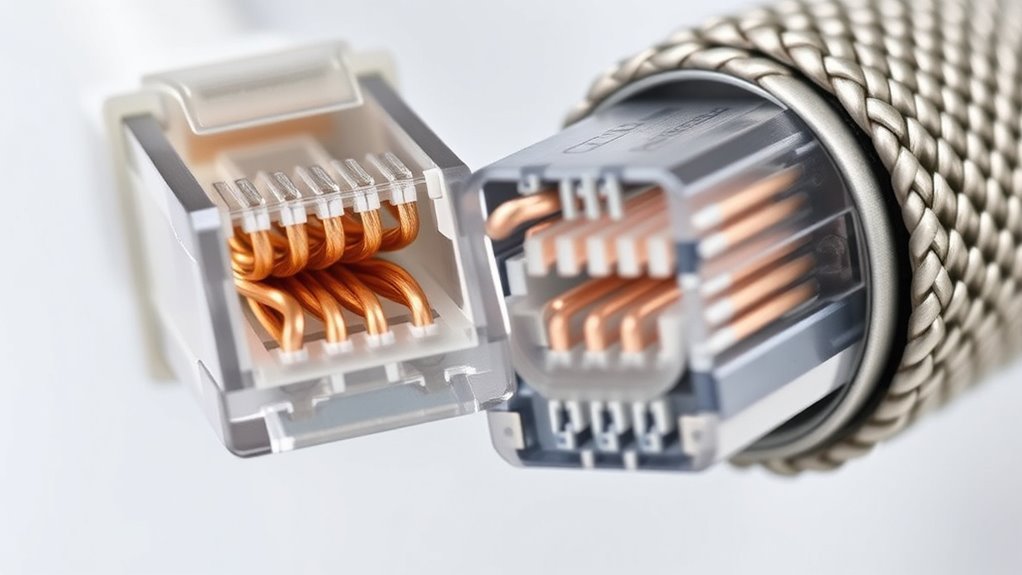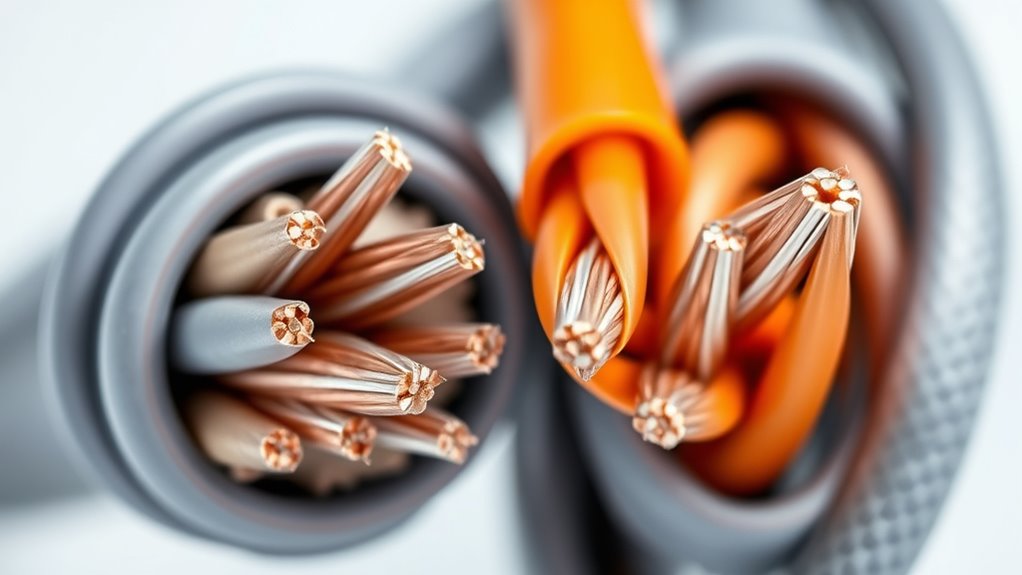UTP cables are unshielded and more flexible, making them ideal for standard office or home setups with minimal interference. STP cables include shielding that reduces electromagnetic interference, which benefits high-EMI environments like factories or data centers. While UTP cables are easier to install and less expensive, STP provides better noise protection and signal integrity. If you want to understand more about which cable suits your needs and their differences, keep exploring the details.
Key Takeaways
- UTP cables lack shielding, are more flexible, and are ideal for low-interference environments like offices and homes.
- STP cables include shielding to block electromagnetic interference, making them suitable for high-EMI areas like factories and data centers.
- STP offers better noise reduction and signal quality over long distances, while UTP is easier and cheaper to install.
- Proper grounding is essential for STP cables to prevent ground loops and maintain signal integrity.
- Choose UTP for cost-effective, simple setups with minimal interference; opt for STP where electromagnetic interference is a concern.

Have you ever wondered what sets UTP and STP cables apart? The answer largely comes down to their shielding effectiveness and how that impacts installation considerations. UTP, or Unshielded Twisted Pair, cables are designed without additional shielding around the individual pairs of wires. This makes them more flexible, easier to install, and generally less expensive. On the other hand, STP, or Shielded Twisted Pair, cables include a shield—like foil or braid—that surrounds the twisted pairs to reduce electromagnetic interference (EMI). This shielding notably improves the cable’s ability to block external noise, making STP a better choice in environments with high EMI, such as factories, data centers, or areas with numerous electrical devices.
UTP cables lack shielding, making them flexible and cost-effective, while STP cables include shields to block electromagnetic interference effectively.
When it comes to shielding effectiveness, STP cables excel because their shields create a barrier that prevents interference from disrupting data transmission. This means you’re less likely to experience signal degradation or data loss, especially over longer distances or in noisy environments. UTP cables, lacking such shielding, are more vulnerable to external interference, which can lead to reduced performance or slower data speeds. However, the absence of shielding also means UTP cables are more flexible and easier to work with, making them ideal for standard office setups and residential applications where interference is minimal.
Installation considerations play a vital role in choosing between UTP and STP. UTP cables are lighter, thinner, and more adaptable, allowing you to run them through walls, ceilings, or conduits without much hassle. Their simplicity makes for faster, more straightforward installations, especially when you’re working in tight spaces or need to run numerous cables. Conversely, STP cables require careful grounding of the shield to avoid creating ground loops, which can introduce noise rather than reduce it. They are also generally thicker and less flexible, which can complicate installation in confined spaces or complex wiring setups. If you’re installing in an environment with high EMI, however, the extra effort to properly install and ground STP cables can be well worth the enhanced shielding effectiveness.
Ultimately, your choice hinges on balancing shielding effectiveness with ease of installation. If your environment is relatively free of interference, UTP offers a cost-effective, simple solution. But if interference poses a substantial concern, investing in STP cables and following proper installation procedures ensures more reliable, high-quality data transmission. Understanding these differences helps you select the right cable type for your specific needs, ensuring your network performs ideally and remains stable over time.
Frequently Asked Questions
Can UTP or STP Cables Be Used Outdoors?
Yes, you can use both UTP and STP cables outdoors, but you should choose ones designed for outdoor durability and weather resistance. Outdoor-rated cables have special insulation and protective coatings that shield against moisture, UV rays, and temperature changes. STP cables offer better interference protection, making them suitable for harsh environments. Always verify the cable is specifically labeled for outdoor use to guarantee peak performance and longevity.
Which Cable Type Offers Better Fire Resistance?
Remember the fiery passion of the 1960s when fire safety was paramount? STP cables offer better fire resistance because they have shielding that reduces heat and flame spread. This makes them more durable in fire-prone environments. If you prioritize cable durability and fire safety, choose STP cables. They’re designed to withstand higher temperatures and prevent fire hazards, giving you peace of mind in critical settings.
Are STP Cables More Expensive Than UTP?
Yes, STP cables tend to be more expensive than UTP cables. The price comparison mainly stems from the additional shielding that provides better protection against interference. This added layer increases manufacturing costs, which you’ll notice reflected in the overall cost difference. If you’re on a tight budget, UTP cables are a more cost-effective choice. However, for environments with high interference, investing in STP cables may be worthwhile despite the higher price.
How Do UTP and STP Cables Handle Electromagnetic Interference?
UTP cables offer less shielding effectiveness, so they provide limited interference reduction against electromagnetic interference (EMI). In contrast, STP cables have shielding that markedly reduces EMI, protecting your data from interference. If you work in environments with high electromagnetic noise, STP cables are better because they handle EMI more effectively. UTP cables are suitable for less noisy environments, but they may not protect your network as well from interference.
Can UTP Cables Be Used for High-Speed Internet?
You might wonder if UTP cables can handle high-speed internet, and the answer is yes, but with caveats. Without cable shielding, UTP cables are more susceptible to interference, which can affect performance. For ideal results, consider installation considerations like proper cable quality and avoiding electrical noise. While UTP can support high speeds, STP cables with shielding provide extra reliability for demanding, high-speed connections.
Conclusion
So, after all this, it’s funny how the “superior” STP cables, with their fancy shielding, can sometimes be overkill, while UTP cables keep things simple and affordable—just like most of us. You’d think extra protection means better, but in reality, it’s about knowing what your setup truly needs. So next time you’re choosing, remember: sometimes, less is more, and overthinking can be the biggest cable conundrum of all.








